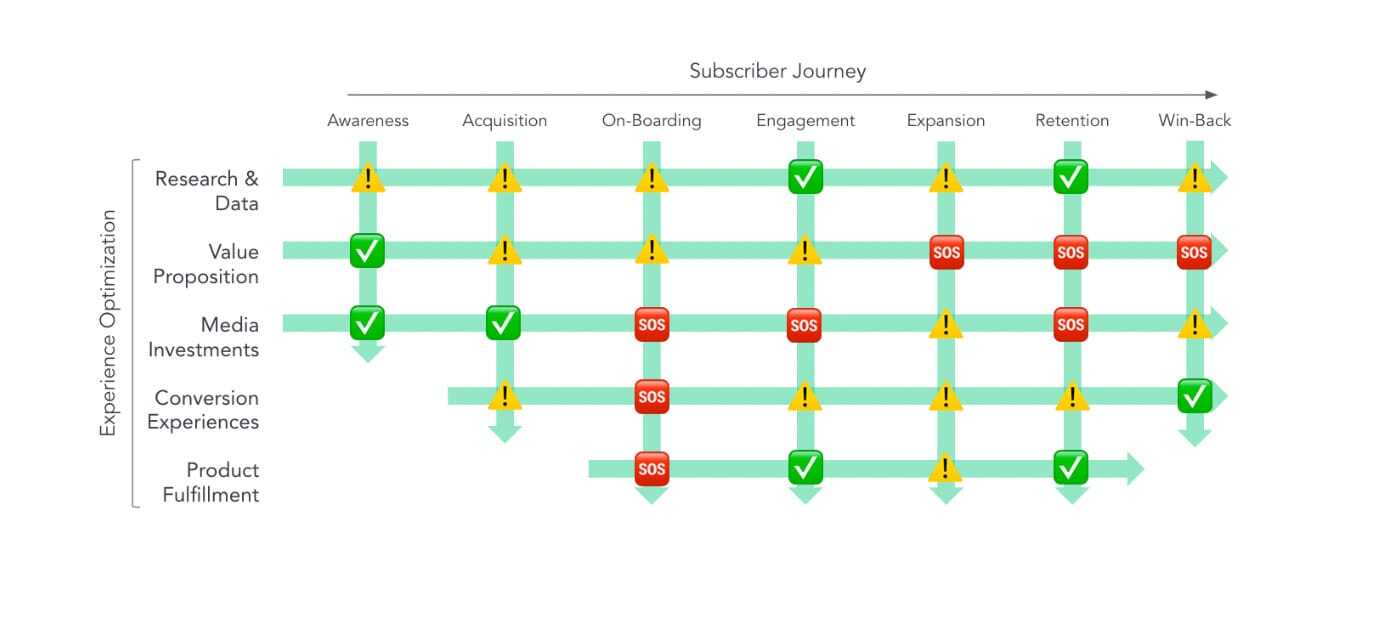
This week, I had a conversation with Steve Hayes, CEO of The Dispatch, a news and politics publisher that in a little over three years is nearing a paid subscriber base of 40,000. That’s doubly impressive considering it has converted so many with a free email list of less than 230,000. First up, a message from House of Kaizen, which works with publishers to get those kinds of results.


The key to sustainable growth is having a system. Subscription programs are no different. House of Kaizen, which works with leading publishers and other brands to optimize their subscriber journey, is hosting a live virtual workshop where you can learn about its subscriber growth framework, a system that builds on 20 years of experience in creating sustainable net growth for subscription, membership and recurring revenue products. The workshop will cover:
The benefits of a subscriber-centric framework
How to optimize the subscriber journey to drive higher lifetime value
The importance of goal alignment
Optimizing touchpoints in the subscriber journey
Aligning subscriber expectations with product experience
Building a culture of optimization

The Dispatch nears 40k paid subscribers
The Dispatch is one of my favorite of the new publications that have sprung up in recent years. For one, it has identified a real need and oddly point of differentiation: It is a center-right publication that skips the shouty nature of politics in favor of fact-based news and analysis. As someone center-left, I can appreciate sanity. It’s also building a solid business in increments. The Dispatch began as a collection of newsletters on Substack and relied on three things that will be crucial to sustainable publishing businesses:
Finding an underserved community to put yourself at the center of;
Pursuing a hybrid model that mixes an institutional brand with personal brands; and
Building a business model that’s aligned with editorial mission.
I revisited the progress The Dispatch has made with its CEO, Steve Hayes. We last spoke when The Dispatch was making the move to leave Substack, since it saw that its ambitions as an independent publishing company didn’t line up with Substack’s move to become more consumer facing. (I always say, nobody is described as “writing a Mailchimp.”) The Dispatch is now 30 people, nearly all of whom work in editorial. That’s because The Dispatch has a subscriptions-based business model with nearly 40,000 paying subscribers and a healthy 17 percent conversion rate from its free email lists. That’s far above the 5-10% most publications benchmark. Steve chalks up the early success to a clear differentiation from the start.
“Part of what people were signing up for was this mission and part of what we were promising was to be different from the existing publications on the center-right, both in terms of the delivery mechanism and how we were going to be communicating with our readers, members and listeners, but also in terms of what we were offering. We were really emphasizing fact-driven analyses and heavy reporting at a time when many on the center-right had turned toward the more efficient, cheaper models of opinion mongering and pure hot takery, anger for anger’s sake, get people pissed off so you can get their eyeballs and you can monetize the scale. We didn’t want to do that.”
I don’t think there’s one way to do just about anything. I do think it’s important in media to have tight alignment between your editorial model and the business model. Too many publishers try to do too many things, creating overly complicated business for the size of them. That leads to bloated infrastructures and a strategic schizophrenia you see clearly when visiting a publisher site and being bombarded with pop-ups imploring you to take different actions.
Having a large base of paying subscribers gives The Dispatch a degree of stability. Hayes says The Dispatch doesn’t do the type of steep discounting many publishers do. Now, it is exploring the addition of an ads business because just about every subscriptions-oriented publisher realizes ads can complement subscription revenue. The operative word is complement, since the risk of advertising-based models is the cart ends up before the horse. Often the needs of advertisers and the needs of the audience are not aligned. Guess who wins 9/10 times in ad-driven publishing?
The challenge for The Dispatch is getting caught in between, with a high value audience but still small for most consumer advertising. The most lucrative area for politics publishers remains the gusher of cash spread around to influence lawmakers and lobbyists. But Steve doesn’t see the point in altering the original editorial mission to satisfy a short-term ad revenue goal.

Publishers use Pressboard to easily measure the success of your sponsored content, ecommerce, and social media campaigns. Check out Pressboard’s most recent Benchmark Report to see how your content measures up to the rest of the industry. The Branded Content Benchmark Report dives into crucial metrics that publishers can use to help better understand and measure branded content success. The report analyzes nearly 6,000 pieces of branded content from 343 publications read by 55 million people. See how your branded content measures up.

Decision time
We go through life making a series of mostly inconsequential decisions. The longer your career goes, and the higher up you progress in organizations, the decisions you make become the core of your contribution. Make enough decisions, you’ll make plenty of bad ones. We see this clearly in the sharp U-Turn Silicon Valley is making from a series of hiring decisions they all made during the pandemic. It’s become something of a ritual for a Silicon Valley CEO to announce thousands of job losses and take responsibility for the decisions that led to these cuts.
On the last episode of the People vs Algorithms podcast, we discuss frameworks for making decisions and the difficult decisions facing many publishing businesses. Subscribe to the podcast here.

Recommendations
This is a strange economic time. The overall global economic outlook is brightening, and many parts of the economy are doing great, others are practically in recession. The tech industry is in pullback mode and that’s hit media and advertising. One of the interesting questions is whether we’re entering a fundamentally different era after a long stretch of cheap credit fueling growth over sustainability. The idea of a “long grind” ahead doesn’t sound particularly fun, especially as “digital media is stuck in an existential quagmire between a fading promise of an old model and a wildly speculative rendering of the future.” It’s no wonder that BuzzFeed is trotting out a new growth story around… AI.
One of the challenges of modern digital publishing is trying to accomplish many things, often at cross purposes. You need to know how you’re going to win. The Daily Beast has good reporting on how Insider (nee Business Insider) figures out what it wants to be: a traffic monster that excels at SEO, aggregation and clicky headlines, or a version of Bloomberg. The worst place to be is in the middle. I applaud the ambition to compete with The New York Times, The Washington Post, Politico, Axios and others on the Washington beat. It’s inevitably hard to cut through with deep, insider content and tie it to subscriptions goals when your identity and playbook are different. What works in tech and business doesn’t necessarily translate to politics.
These wild swings feed the deep well of dissatisfaction in the ranks. Luke Winkie has a very honest view of the life of a professional writer, hardly a blueprint for a stable life: The media industry is currently in the midst of one of its bleakest seasons on record, so this tumult has been more common than usual.”
One thing is for sure, companies are using economic issues to reset expectations with their workforces. This is often overblown in my view. The experiences of tech workers, as exemplified in the day in the life TikToks, bears little resemblance to the day at the office of just about everybody else. But there’s little doubt we’ll see companies be more assertive with their workforces on demands for pay increases, remote work and even DEI initiatives. I’ll be interested to see what comes out of this threatened strike by HuffPost workers. After all, parent company BuzzFeed’s stock rose sharply on news it would use AI to construct listicles and quizzes while getting paid by Meta to train influencers. Wall Street loves an efficiency story, which is typically a way to more with fewer people.
What a post-zero interest rate era Wall Street doesn’t like so much is pouring money into unprofitable content initiatives. Companies need profits more than a glitzy growth story. Spotify is the latest platform to backtrack on its original content strategy. Creating hits is very attractive (and expensive), only you need to have the stomach to have a ton of flops. Spotify’s free spending days are behind it, following a string of acquisitions of podcast studios and cutting exclusive deals with podcast stars like Joe Rogan. Instead, Spotify is beating a retreat to where platforms are most comfortable: hosting tons of content they don’t pay for, acting as an ad middleman. Sometimes, it pays not to overthink it.
Speaking of podcasts, The Webby Awards celebrate the best of the Internet -- and that includes podcasts. The Webbys has an expanded podcast category, with awards for best podcast for business, news and politics, lifestyle and more. Last year’s winners included LeVar Burton Reads, Masters of Scale and The History Channel and The Washington Post. Enter by the extended entry deadline on Friday, Feb 10 at webbyawards.com. (Sponsored)
Newsletter I like: The Sunday Long Read is an example of a magazine-like newsletter format, curating the best of longform journalism of the week. I appreciate these types of newsletters because Twitter these days is an inefficient method of finding hidden gems amid the chaos of preening, fighting and marketing threads. Check out The Sunday Long Read

.
Thanks for reading. Send me feedback by hitting reply or emailing me at [email protected].
If you’re interested in sponsoring The Rebooting and, check out the sponsorship options and get in touch.